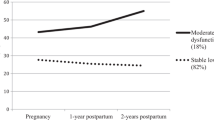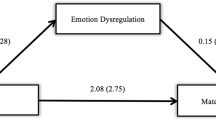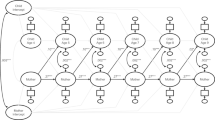Abstract
Research has suggested that parenting behaviors and other parental factors impact the long-term outcome of children’s posttraumatic stress disorder (PTSD) symptoms. In a sample of 62 children between the ages of one and six who experienced life-threatening traumas, PTSD was measured prospectively 2 years apart. Seven maternal factors were measured in a multi-method, multi-informant design. Both moderation and mediation models, with different theoretical and mechanism implications, were tested. Moderation models were not significant. Mediation models were significant when the mediator variable was maternal symptoms of PTSD or depression (measured at Time 1), self-report of maternal escape/avoidance coping (measured at Time 2), or self-report emotional sensitivity (measured at Time 2). Greater maternal emotional sensitivity was associated with greater Time 2 PTSD symptoms among children. Observational measures of emotional sensitivity as the mediator were not supported. Correlation of parents’ and children’s symptoms is a robust finding, however caution is warranted in attributing children’s PTSD symptoms to insensitive parenting.
Similar content being viewed by others
References
Achenbach, T. M., & Edelbrock, C. (1983). Manual for the child behavior checklist and revised child behavior profile. Burlington: University of Vermont, Department of Psychiatry.
Afifi, T. O., Asmundson, G. J. G., Taylor, S., & Jang, K. L. (2010). The role of genes and environment on trauma exposure and posttraumatic stress disorder symptoms: a review of twin studies. Clinical Psychology Review, 30, 101–112. doi:10.1016/j.cpr.2009.10.002.
Allenou, C., Olliac, B., Bourdet-Loubère, S., Brunet, A., David, A. C., Claudet, I., & Birmes, P. (2010). Symptoms of traumatic stress in mothers of children victims of a motor vehicle accident. Depression and Anxiety, 27, 652–657. doi:10.1037/t00456-000.
Beck, A. T., Steer, R. A., & Garbin, M. G. (1988). Psychometric properties of the Beck depression inventory: twenty-five years of evaluation. Clinical Psychology Review, 8, 77–100. doi:10.1016/0272-7358(88)90050-5.
Belsky, J., & de Haan, M. (2011). Annual research review: parenting and children’s brain development: the end of the beginning. Journal of Child Psychology and Psychiatry, 52(4), 409–428. doi:10.1111/j.1469-7610.2010.02281.x.
Birmes, P., Raynaud, J. P., Daubisse, L., Brunet, A., Arbus, C., Klein, R., & Schmitt, L. (2009). Children’s enduring PTSD symptoms are related to their family’s adaptability and cohesion. Community Mental Health Journal, 45(4), 290–299. doi:10.1007/s10597-008-9166-3.
Bokszczanin, A. (2008). Parental support, family conflict, and overprotectiveness: predicting PTSD symptom levels of adolescents 28 months after a natural disaster. Anxiety, Stress & Coping: An International Journal, 21(4), 325–335. doi:10.1080/10615800801950584.
Bryant, R. A., Marosszeky, J. E., Crooks, J., Baguley, I., & Gurka, J. (2000). Coping style and post-traumatic stress disorder following severe traumatic brain injury. Brain Injury, 14, 175–180. doi:10.1080/026990500120826.
Cohen, J. A., & Mannarino, A. P. (1996). Factors that mediate treatment outcome of sexually abused preschool children. Journal of the American Academy of Child and Adolescent Psychiatry, 35, 1402–1410. doi:10.1097/00004583-199610000-00028.
Crockenberg, S., & Leerkes, E. (2000). Infant social and emotional development in family context. In C. Zeanah (Ed.), Handbook of infant mental health (2nd ed., pp. 60–90). New York: Guilford.
Crowell, J. A., & Feldman, S. S. (1989). Mothers’ internal models of relationships and children’s behavioral and developmental status: a study of mother-child interaction. Child Development, 59, 1273–1285. doi:10.2307/1130490.
Crowell, J. A., Feldman, S. S., & Ginsberg, N. (1988). Assessment of mother-child interaction in preschoolers with behavior problems. Journal of the American Academy of Child and Adolescent Psychiatry, 27, 303–311. doi:10.1097/00004583-198805000-00007.
Daley, D., Sonuga-Barke, E. J. S., & Thompson, M. (2003). Assessing expressed emotion in mothers of preschool AD/HD children: psychometric properties of a modified speech sample. British Journal of Clinical Psychology, 42, 53–67. doi:10.1348/014466503762842011.
Davidson, J.R.T. (1995). Davidson Trauma Scale: Multi-Health Systems, Inc.
Davidson, J. R. T., Book, S. W., Colket, J. T., Tupler, L. A., Roth, S., David, D., & Feldman, M. E. (1997). Assessment of a new self-rating scale for post-traumatic stress disorder. Psychological Medicine, 27(1), 153–160. doi:10.1017/S0033291796004229.
Davidson, J. R. T., Tharwani, H. M., & Connor, K. M. (2002). Davidson Trauma Scale (DTS): normative scores in the general population and effect sizes in placebo-controlled SSRI trials. Depression and Anxiety, 15, 75–78. doi:10.1002/da.10021.
Deblinger, E., Steer, R., & Lipmann, J. (1999). Maternal factors associated with sexually abused children’s psychosocial adjustment. Child Maltreatment: Journal of the American Professional Society on the Abuse of Children, 4, 13–20.
Dekel, R., & Goldblatt, H. (2008). Is there intergenerational transmission of trauma? The case of combat veterans’ children. American Journal of Orthopsychiatry, 78(3), 281–289. doi:10.1037/a0013955.
Eid, J., Johnsen, B. H., & Thayer, J. F. (2001). Post-traumatic stress symptoms following a shipwreck of a Norwegian Navy frigate - an early follow-up. Personality and Individual Differences, 30, 1283–1295. doi:10.1016/S0191-8869(00)00111-2.
Eyberg, S.M., & Robinson, E.A. (1981). Dyadic parent–child interaction coding system: a manual. Psychological Documents, 13(MS No. 2582).
Famularo, R., Fenton, T., Kinscherff, R., Ayoub, C., & Barnum, R. (1994). Maternal and child posttraumatic stress disorder in cases of child maltreatment. Child Abuse and Neglect, 18, 27–36. doi:10.1016/0145-2134(94)90093-0.
Feldman, R., & Vengrober, A. (2011). Posttraumatic stress disorder in infants and young children exposed to war-related trauma. Journal of the American Academy of Child and Adolescent Psychiatry, 50(7), 645–658. doi:10.1016/j.jaac.2011.03.001.
Folkman, S., & Lazarus, R. S. (1988). Ways of coping questionnaire: review set, manual, test booklet, scoring key. Redwood City: Mind Garden, Inc.
Gewirtz, A. H., Forgatch, M., & Wieling, E. (2008). Parenting practices as potential mechanisms for child adjustment following mass trauma. Journal of Marital and Family Therapy, 34(2), 177–192. doi:10.1111/j.1752-0606.2008.00063.x.
Gewirtz, A. H., Degarmo, D. S., & Medhanie, A. (2011). Effects of mother’s parenting practices on child internalizing trajectories following partner violence. Journal of Family Psychology, 25(1), 29–38. doi:10.1037/t06334-000.
Kellerman, N. P. F. (2001). Psychopathology in children of Holocaust survivors: a review of the research literature. Israel Journal of Psychiatry and Related Sciences, 38(1), 36–46.
Kelley, M. L., Self-Brown, S., Le, B., Bosson, J. V., Hernandez, B. C., & Gordon, A. T. (2010). Predicting posttraumatic stress symptoms in children following Hurricane Katrina: a prospective analysis of the effect of parental distress and parenting practices. Journal of Traumatic Stress, 23(5), 582–590. doi:10.1002/jts.20573.
Koenen, K. C. (2007). Genetics of posttraumatic stress disorder: review and recommendations for future studies. Journal of Traumatic Stress, 20(5), 737–750. doi:10.1002/jts.20205.
Koplewicz, H. S., Vogel, J. M., Solanto, M. V., Morrissey, R. F., Alonso, C. M., Abikoff, H., & Novick, R. M. (2002). Child and parent response to the 1993 World Trade Center bombing. Journal of Traumatic Stress, 15(1), 77–85. doi:10.1023/A:1014339513128.
Kraemer, H. C., Wilson, G. T., Fairburn, C. G., & Agras, S. (2002). Mediators and moderators of treatment effects in randomized clinical trials. Archives of General Psychiatry, 59, 877–883. doi:10.1001/archpsyc.59.10.877.
Kraemer, H. C., Kiernan, W., Essex, M. J., & Kupfer, D. J. (2008). How and why criteria defining moderators and mediators differ between the Baron & Kenny and MacArthur approaches. Health Psychology, 27(2, suppl), S101–S108. doi:10.1037/0278-6133.27.2.
Kuppens, S., Grietens, H., Onghena, P., & Michiels, D. (2009). Relations between parental psychological control and childhood relational aggression: reciprocal in nature? Journal of Clinical Child and Adolescent Psychology, 38(1), 117–131. doi:10.1080/15374410802575354.
Lachenbruch, P. A. (1988). A note on sample size computations for testing interactions. Statistics in Medicine, 7, 467–469.
Laor, N., Wolmer, L., Mayes, L. C., & Gershon, A. (1997). Israeli preschool children under scuds: a 30-month follow-up. Journal of the American Academy of Child and Adolescent Psychiatry, 36, 349–356. doi:10.1097/00004583-199703000-00013.
Le Brocque, R. M., Hendrikz, J., & Kenardy, J. (2010). Parental response to child injury: examination of parental posttraumatic stress symptom trajectories following child accidental injury. Journal of Pediatric Psychology, 35(6), 646–655. doi:10.1093/jpepsy/jsq035.
Levendosky, A. A., & Graham-Bermann, S. A. (2001). Parenting in battered women: the effects of domestic violence on women and their children. Journal of Family Violence, 16(2), 171–192. doi:10.1023/A:1011111003373.
Levendosky, A. A., Huth-Bocks, A. C., Shapiro, D. L., & Semel, M. A. (2003). The impact of domestic violence on the maternal-child relationship and preschool-age children’s functioning. Journal of Family Psychology, 17(3), 275–287. doi:10.1037/0893-3200.17.3.275.
Lieberman, A. F., Ippen, C. G., & Van Horn, P. (2006). Child–parent psychotherapy: 6-month follow-up of a randomized controlled trial. Journal of the American Academy of Child and Adolescent Psychiatry, 45(8), 913–918. doi:10.1097/01.chi.0000222784.03735.92.
Lockwood, C.M., & MacKinnon, D.P. (1998). Bootstrapping the standard error of the mediated effect. Paper presented at the 23rd Annual Meeting of SAS Users Group International.
MacKinnon, D. P. (2008). Computer intensive methods for mediation models Introduction to Statistical Mediation Analysis (pp. 325–346). New York: Taylor & Francis Group/Lawrence Erlbaum Associates.
MacKinnon, D. P., Lockwood, C. M., & Williams, J. (2004). Confidence limits for the indirect effect: distribution of the product and resampling methods. Multivariate Behavioral Research, 39(1), 99–128. doi:10.1207/s15327906mbr3901_4.
McFarlane, A. C. (1987). Posttraumatic phenomena in a longitudinal study of children following a natural disaster. Journal of the American Academy of Child and Adolescent Psychiatry, 26, 764–769. doi:10.1097/00004583-198709000-00025.
Meiser-Stedman, R., Smith, P., Glucksman, E., Yule, W., & Dalgleish, T. (2008). The posttraumatic stress disorder diagnosis in preschool- and elementary school-age children exposed to motor vehicle accidents. American Journal of Psychiatry, 165(10), 1326–1337. doi:10.1176/appi.ajp.2008.07081282.
Neece, C. L., Green, S. A., & Baker, B. L. (2012). Parenting stress and child behavior problems: a transactional relationship across time. American Journal on Intellectual & Developmental Disabilities, 117(1), 48–66. doi:10.1352/1944-7558-117.1.48.
Pelcovitz, D., Libov, B. G., Mandel, F., Kaplan, S., Weinblatt, M., & Septimus, A. (1998). Posttraumatic stress disorder and family functioning in adolescent cancer. Journal of Traumatic Stress, 11, 205–221.
Rudd, M. D., & Rajab, M. H. (1995). Specificity of the Beck Depression Inventory and the confounding role of comorbid disorders in a clinical sample. Cognitive Therapy and Research, 19, 51–68. doi:10.1007/BF02229676.
Sameroff, A.J., Thomas, S.L., & Barrett, L.C. (1990). Anxiety and parental childrearing styles. Paper presented at the Society for Research in Adolescence, Atlanta, GA.
Schechter, D. S., Willheim, E., Hinojosa, C., Scholfield-Kleinman, K., Turner, J. B., McCaw, J. E., & Myers, M. M. (2010). Subjective and objective measures of parent–child relationship dysfunction, child separation distress, and joint attention. Psychiatry, 73(2), 130–144. doi:10.1521/psyc.2010.73.2.130.
Scheeringa, M. S. (2002). Posttrauma Inventory of Parental Style (PIPS). New Orleans: Tulane University School of Medicine.
Scheeringa, M. S., & Zeanah, C. H. (2001). A relational perspective on PTSD in early childhood. Journal of Traumatic Stress, 14(4), 799–815. doi:10.1023/A:1013002507972.
Scheeringa, M. S., Zeanah, C. H., Drell, M. J., & Larrieu, J. A. (1995). Two approaches to the diagnosis of posttraumatic stress disorder in infancy and early childhood. Journal of the American Academy of Child and Adolescent Psychiatry, 34(2), 191–200.
Scheeringa, M. S., Peebles, C. D., Cook, C. A., & Zeanah, C. H. (2001). Toward establishing procedural, criterion, and discriminant validity for PTSD in early childhood. Journal of the American Academy of Child and Adolescent Psychiatry, 40(1), 52–60. doi:10.1097/00004583-200101000-00016.
Scheeringa, M. S., Zeanah, C. H., Myers, L., & Putnam, F. W. (2003). New findings on alternative criteria for PTSD in preschool children. Journal of the American Academy of Child and Adolescent Psychiatry, 42(5), 561–570. doi:10.1097/01.CHI.0000046822.95464.14.
Scheeringa, M. S., Zeanah, C. H., Myers, L., & Putnam, F. W. (2005). Predictive validity in a prospective follow-up of PTSD in preschool children. Journal of the American Academy of Child and Adolescent Psychiatry, 44(9), 899–906. doi:10.1097/01.chi.0000169013.81536.71.
Scheeringa, M.S., Myers, L, Putnam, F.W., & Zeanah, C.H. (2012). Diagnosing PTSD in early childhood: an empirical assessment of four approaches. Journal of Traumatic Stress, On lone early view doi: 10.1002/jts.21723.
Shaffer, D., Fisher, P., & Lucas, C. P. (2000). NIMH Diagnostic Interview Schedule for Children Version IV (NIMH DISC-IV): description, differences from previous versions, and reliability of some common diagnoses. Journal of the American Academy of Child and Adolescent Psychiatry, 39(1), 28–38. doi:10.1097/00004583-200001000-00014.
Shrout, P. E., & Bolger, N. (2002). Mediation in experimental and nonexperimental studies: new procedures and recommendations. Psychological Methods, 7(4), 422–445. doi:10.1037/1082-989X.7.4.422.
Silk, J. S., Ziegler, M. L., Whalen, D. J., Dahl, R. E., Ryan, N. D., Dietz, L. J., & Williamson, D. E. (2009). Expressed emotion in mothers of currently depressed, remitted, high-risk, and low-risk youth: links to child depression status and longitudinal course. Journal of Clinical Child and Adolescent Psychology, 38(1), 36–47. doi:10.1080/15374410802575339.
Thabet, A. A., Ibraheem, A. N., Shivram, R., Winter, E. A., & Vostanis, P. (2009). Parenting support and PTSD in children of a war zone. International Journal of Social Psychiatry, 55(3), 226–237. doi:10.1177/0020764008096100.
Wilson, A. C., Lengua, L. J., Meltzoff, A. N., & Smith, K. A. (2010). Parenting and temperament prior to September 11, 2001, and parenting specific to 9/11 as predictors of children’s posttraumatic stress symptoms following 9/11. Journal of Clinical Child and Adolescent Psychology, 39(4), 445–459. doi:10.1080/15374416.2010.486317.
Zeanah, C. H., Boris, N. W., & Larrieu, J. A. (1997a). Infant development and developmental risk: a review of the past 10 years. Journal of the American Academy of Child and Adolescent Psychiatry, 36(2), 165–178. doi:10.1097/00004583-199702000-00007.
Zeanah, C. H., Boris, N. W., & Scheeringa, M. S. (1997b). Psychopathology in infancy. Journal of Child Psychology and Psychiatry, 38, 81–99. doi:10.1111/j.1469-7610.1997.tb01506.x.
Author Note
M.S. Scheeringa, Department of Psychiatry and Behavioral Sciences, Tulane University School of Medicine; L. Myers, Department of Biostatistics and Bioinformatics, Tulane University School of Public Health and Tropical Medicine; F.W. Putnam, Department of Psychiatry, University of North Carolina; C.H. Zeanah, Department of Psychiatry and Behavioral Sciences, Tulane University School of Medicine.
This research was supported by NIMH grant MH01706 to Dr. Michael S. Scheeringa.
Author information
Authors and Affiliations
Corresponding author
Rights and permissions
About this article
Cite this article
Scheeringa, M.S., Myers, L., Putnam, F.W. et al. Maternal Factors as Moderators or Mediators of PTSD Symptoms in Very Young Children: A Two-Year Prospective Study. J Fam Viol 30, 633–642 (2015). https://doi.org/10.1007/s10896-015-9695-9
Published:
Issue Date:
DOI: https://doi.org/10.1007/s10896-015-9695-9




